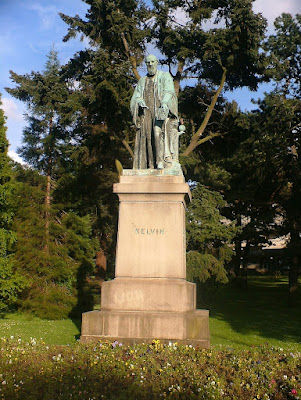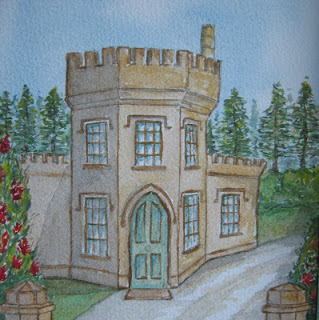THE DOBBS FAMILY OWNED 5,060 ACRES OF LAND IN COUNTY ANTRIM
JOHN DOBBS, only son of Sir Richard Dobbs (a founder of Christ's Hospital and Lord Mayor of London, 1551).
 |
| Sir Richard Dobbs. Photo credit: Christ's Hospital Foundation |
This John Dobbs accompanied Sir Henry Docwra to the province in 1596, and was subsequently his deputy as treasurer for Ulster.
He wedded, in 1603, Margaret, only child of John Dalway, of Ballyhill, and had two sons, Foulk, who was lost at sea, with his father, in returning from England in 1622; and
HERCULES DOBBS (1613-34), who, succeeding to his father's property, married Magdalen West, of Ballydugan, County Down, and left an only son,
RICHARD DOBBS (1634-1701), of Castle Dobbs, High Sheriff of County Antrim, 1664, who wedded, in 1665, Dorothy, daughter and co-heir of Bryan Willans, of Clints Hall, Richmond, Yorkshire, and had (with three daughters), two sons.
Mr Dobbs left his estate to his younger son,
RICHARD DOBBS (1660-1711), of Castle Dobbs, High Sheriff of County Antrim, 1694, who espoused firstly, Mary, daughter of Archibald Stewart, of Ballintoy, and had (with two daughters) three sons,
ARTHUR, his heir;He married secondly, Margaret Clugston, of Belfast, and had three daughters.
Richard (Rev), Rector of Lisburn;
Marmaduke.
Mr Dobbs served in WILLIAM III's army in Ireland until the second siege of Limerick and the Treaty of Surrender.
On the 14th June, 1690, he welcomed Prince William of Orange on his landing in Ulster as Mayor of Carrickfergus.
Mr Dobbs was succeeded by his eldest son,
ARTHUR DOBBS (1689-1765), of Castle Dobbs, High Sheriff of County Antrim, 1720, MP for Carrickfergus, 1727-41, who wedded Anne, daughter of Captain Osborne, of Timahoe, County Kildare, and widow of Captain Norbury, by whom he had issue.
 |
| Arthur Dobbs, 6th Governor of North Carolina |
He was appointed Engineer and Surveyor-General of Ireland, by Sir Robert Walpole, and was, in 1753, sent out as Governor of North Carolina, where he acquired large possessions, including 400,000 acres in the colony.
Arthur Dobbs was succeeded by his eldest son,
CONWAY RICHARD DOBBS (1727-1811), of Castle Dobbs, MP for Carrickfergus, 1768-85, High Sheriff of County Antrim, 1752, who married firstly, in 1749, Anne, daughter of Alexander Stewart, and had issue,
RICHARD, his heir.He wedded secondly, Charity, widow of Stephen Rice, of Mount Rice, County Kildare, and daughter of Robert Borrowes, of Kildare, by Mary, his wife, daughter of John O'Neill, of Shane's Castle, and had further issue,
Edward Brice, twice Mayor of Carrickfergus;Mr Dobbs was succeeded by his son,
Robert Conway (Rev);
Frances.
RICHARD DOBBS (1753-1840), of Castle Dobbs, who espoused, in 1792, Nichola, daughter of Michael Obins, of Portadown, County Armagh, by Nichola his wife, second daughter of Archibald, 1st Viscount Gosford, and had issue,
CONWAY RICHARD, his heir;Mr Dobbs was succeeded by his eldest son,
Archibald Edward, barrister, father of ARCHIBALD EDWARD DOBBS;
Acheson;
Nichola; Frances; Olivia.
CONWAY RICHARD DOBBS JP DL (1796-1886), of Castle Dobbs, High Sheriff of County Antrim, 1841, MP for Carrickfergus, 1832, who married, in 1826, Charlotte Maria, daughter and co-heiress of William Sinclair, of Fort William, County Antrim, and had issue,
Richard Archibald Conway (1842-53);
MONTAGU WILLIAM EDWARD, his heir;
Olivia Nichola; Frances Millicent; Charlotte Louisa Mary; Alicia Hester Caroline;
Harriet Sydney; Nichola Susan; Millicent Georgina Montagu.
He wedded secondly, in 1875, Winifred Susannah, youngest daughter of Benjamin Morris, of Lewes, Sussex.
Mr Dobbs was succeeded by his eldest surviving son,
MONTAGU WILLIAM EDWARD DOBBS JP DL (1844-1906), of Castle Dobbs, High Sheriff of County Kildare, 1871, County Antrim, 1888, Barrister, who was succeeded by his cousin,
ARCHIBALD EDWARD DOBBS JP (1838-1916), of Castle Dobbs, High Sheriff of County Antrim, 1909, Barrister, who espoused, in 1875, Edith Mary, second daughter of Sir James Timmins Chance Bt, and had issue,
ARTHUR FREDERICK DOBBS DL (1876-1955), High Sheriff of County Antrim, 1921, who married, in 1915, Hylda Louise, daughter of Conway Richard Dobbs Higginson, and had issue,
SIR RICHARD ARTHUR FREDERICK DOBBS KCVO JP, Barrister, Judge of the Circuit Court, 1951-55, Midland Circuit, Lord-Lieutenant of County Antrim, 1959-94, Knight Commander of the Royal Victorian Order, who wedded, in 1953, Carola Day, daughter of Christopher Clarkson, and had issue,
Mr Dobbs was succeeded by his eldest surviving son,
MONTAGU WILLIAM EDWARD DOBBS JP DL (1844-1906), of Castle Dobbs, High Sheriff of County Kildare, 1871, County Antrim, 1888, Barrister, who was succeeded by his cousin,
ARCHIBALD EDWARD DOBBS JP (1838-1916), of Castle Dobbs, High Sheriff of County Antrim, 1909, Barrister, who espoused, in 1875, Edith Mary, second daughter of Sir James Timmins Chance Bt, and had issue,
ARTHUR FREDERICK, his heir;Mr Dobbs was succeeded by his eldest son,
Francis Wellesley;
Archibald Edward.
ARTHUR FREDERICK DOBBS DL (1876-1955), High Sheriff of County Antrim, 1921, who married, in 1915, Hylda Louise, daughter of Conway Richard Dobbs Higginson, and had issue,
RICHARD ARTHUR FREDERICK, his heir;Mr Dobbs was succeeded by his son and heir,
Joan Kathleen.
SIR RICHARD ARTHUR FREDERICK DOBBS KCVO JP, Barrister, Judge of the Circuit Court, 1951-55, Midland Circuit, Lord-Lieutenant of County Antrim, 1959-94, Knight Commander of the Royal Victorian Order, who wedded, in 1953, Carola Day, daughter of Christopher Clarkson, and had issue,
Richard Francis Andrew, b 1955;
Nigel Christopher, b 1957; High Sheriff of County Antrim, 2009;
Matthew Frederick, b 1959;
Nicholas Arthur Montagu, b 1973;
Sophia Carola, b 1965.
The eldest son,
Richard Francis Andrew Dobbs, married, in 1980, the Lady Jane Alexander, sister of 7th Earl of Caledon; divorced in 1999 and had issue, three daughters.
Richard Francis Andrew Dobbs, married, in 1980, the Lady Jane Alexander, sister of 7th Earl of Caledon; divorced in 1999 and had issue, three daughters.
I HAVE written about Castle Dobbs here.
First published in August, 2012.















.JPG)



















